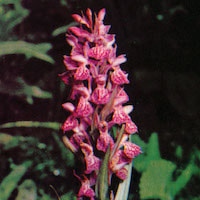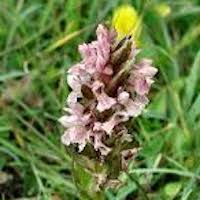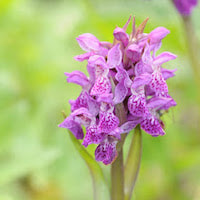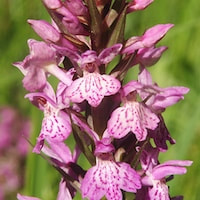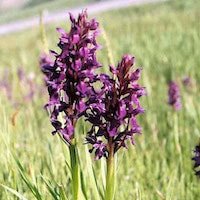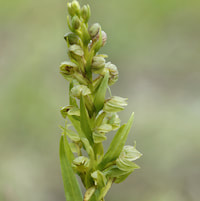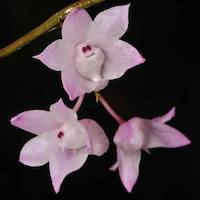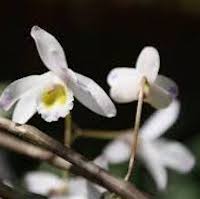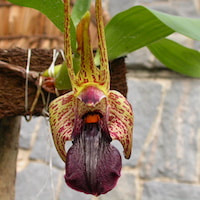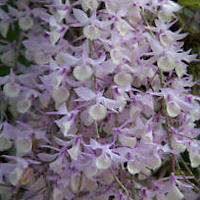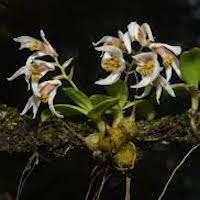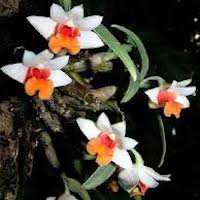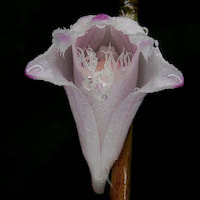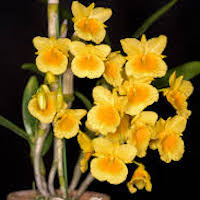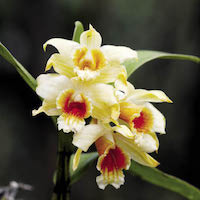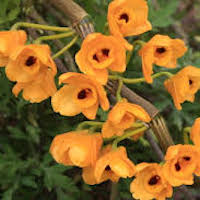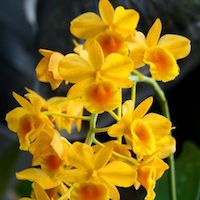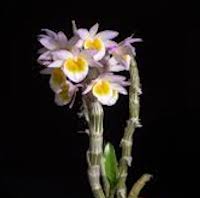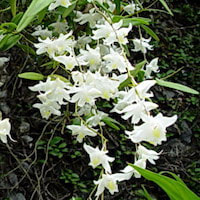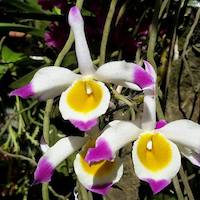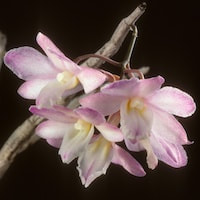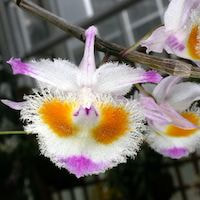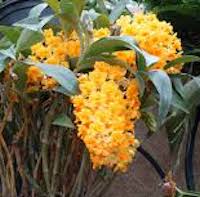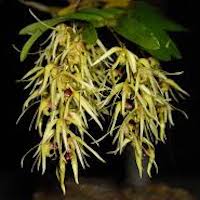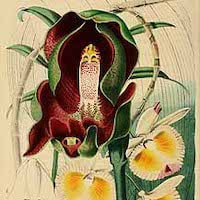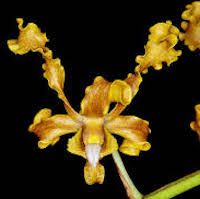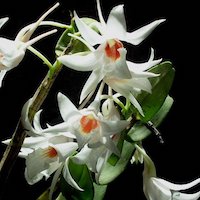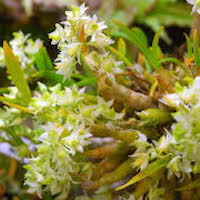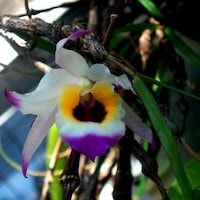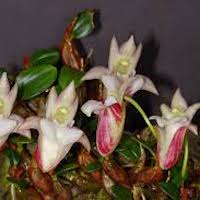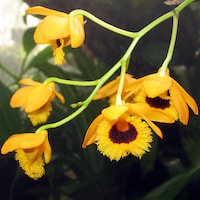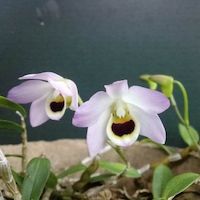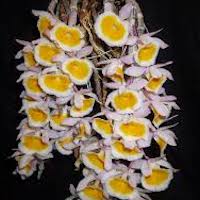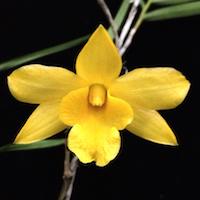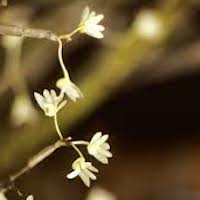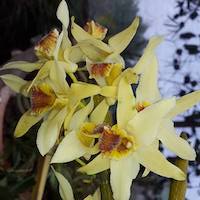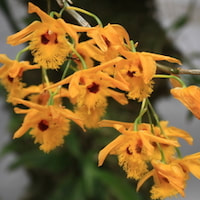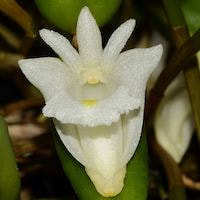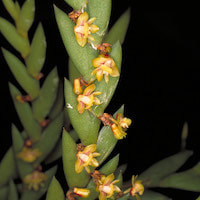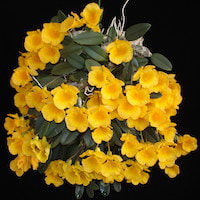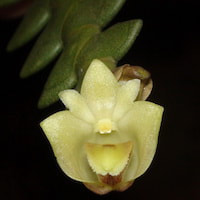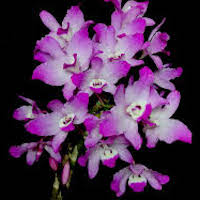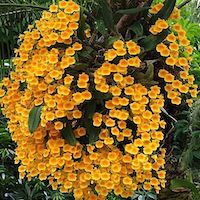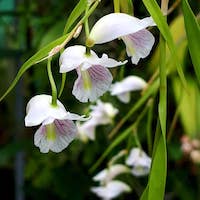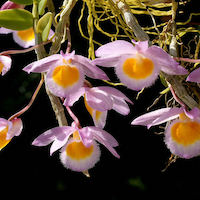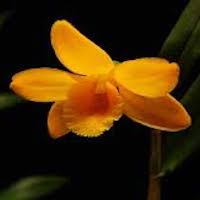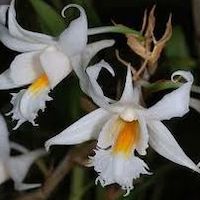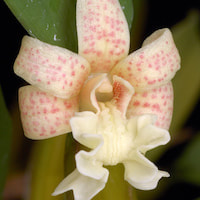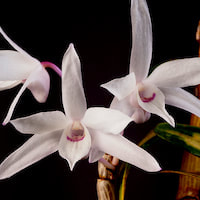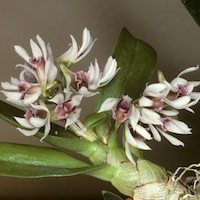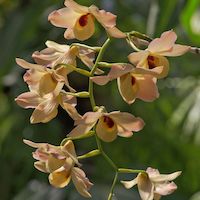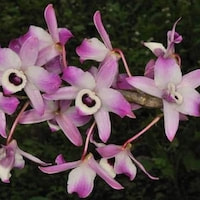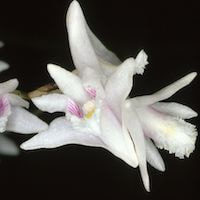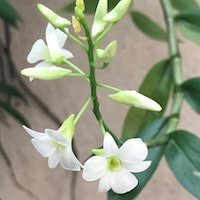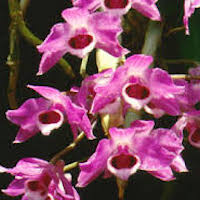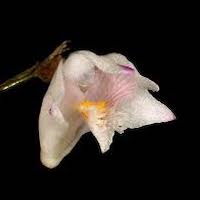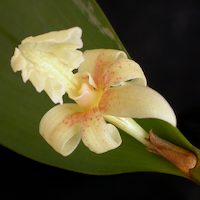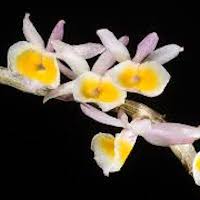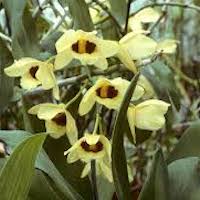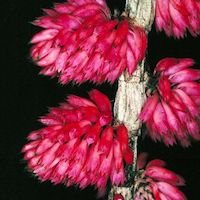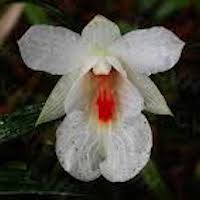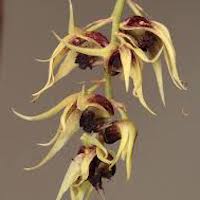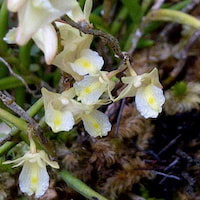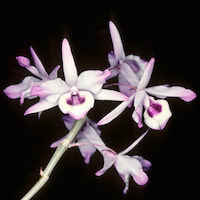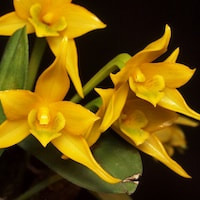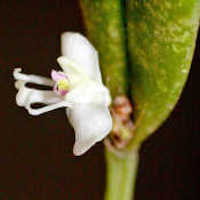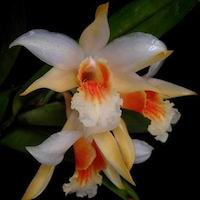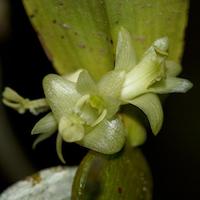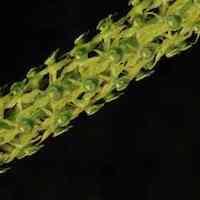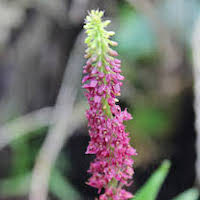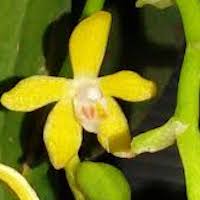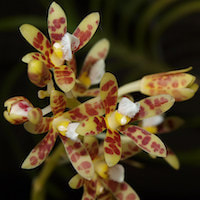|
Dactylorhiza hatagirea (D. Don) Soo syn. Orchis latifolia Lindl.
Common name: Marsh Orchid Chinese names: Kuanyehongmen Lan (broad leaf red door orchid), Hongmen Lan (red door orchid), Mengguhongmen Lan (Mongolian red door orchid), Zhanglie Lan Chinese medicinal name: Hongmen Lan (red door orchid) Indian names: Munjataka in Ayurveda, Panja, Salampanja, Salep, Salap (Hindi), Salap (Sanskrit), Salimpanja (Kashmir Himalaya), Hathazari (Uttarakhand) Nepali names: Hathejadi is the common name; Lob, Panchaunle (Gurung), Panchaunle (Nepali), Ongu lakpa (Sherpa), dbang-po-lag (Tibetan), Wonglak (Amchi), Lovha (Kham), Airalu (Sanskrit) Spanish name: Palma Christi Herbal Usage: Rhizomes of D. hatagirea are a source of salep in Turkey. They are used as expectorant, tonic, astringent and nutrient in India. Tubers are eaten raw for their aphrodisiac properties in India. In Kashmir Himalaya, it is also used in the treatment of diabetes, chronic diarrhoea, dysentery, coughs, hoarseness of voice, paralysis, impotence, and during convalescence and to correct malnutrition. In Uttarakhand and a paste made with tubers is applied on fractures. In Nepal decoction of the root is taken for stomach ache. It was considered to be highly nutritious! In Chinese herbal medicine, the entire plant is used as a cardiac stimulant. It is alleged to benefit the kidney, stomach and spleen. It relieves thirst, improves appetite and is used to treat irregular menstruation, anaemia and dizziness. |
|
Dactylorhiza salina (Turez exLindl.) Soo
Mongolian name: Martsnii tsakhiram Tibetan name: Ban lag In Mongolia, it is found in damp, swampy alkaline meadows in almost all natural zones. Herbal usage: Root tubers are reported as sweet and astringent. They are used to treat oedema and inflammation, to give strength and enhance life. There is a special demand for this orchid in Mongolia and it is an ingredient in several traditional Mongolian prescriptions. |
|
Dactyloriza umbrosa (Kar and Kir.) Nevski
Common name: Dark Dactylorhiza Chinese name: Yin Sheng Zhang Lie Lan This is a robust species which thrives in temperate and sub-artic regions of Asia. It is also distributed in Pakistan, Afghanistan and northern Iran. Usage: It is used to prepare salep and is being harvested in Iran. |
|
Dactylorhiza viridis (Linn.) R.M. Bateman, Pridgeon and M.W. Chase syn. Coeloglossum viride Hartm.
Chinese names: Woshe Lan (nest tongue orchid), Luhua-woshe Lan (green flower nest tongue orchid, Nanhulinyuzi Lan (South Lake orchid), Aoshe Lan (nest tongue orchid), Shoushen (hand ginseng), Aoshezhanglie Lan Tibetan medicinal name: Wangla Alaskan name: frog orchid It's a winter orchid. In Alaska, the temperature may drop to minus 50 oC in winter, with severe desiccation during long winter months, yet the orchid survives. Phytochemistry: The functional groups of the compounds suggest that D. viride extracts may have a neuroprotective effect. Aphrodisiacal properties of D. hatagirea were studied in Wistar strain male albino rats. Rats fed the orchid had a 2.5-fold increase in attraction to females compared with the testosterone-treated. In Singapore and other parts of southern Asia, one may find the orchid among the constituents of health supplements which are marketed as revitalising, rejuvenating, or aphrodisiac. Dactylorhiza as salep is also considered to be an aphrodisiac in Iran, Turkey and the Colchis Forest area of Georgia in the Caucasus. |
|
Dendrobium aduncum Lindl. Syn D. scorianum W. W. Smith, D. faulhaberianum Schltr.
Chinese names: Gouzhuangshihu (noble hook Dendrobium), Huangcaoshihu (yellow herbal Dendrobium); Dahuangcao (large yellow herbal Dendrobium); Honglancao (red orchid herb); Jishengcao (parasitic herb) It is widely distributed from the Himalayan foothills to Kwangtung Province and Hong Kong, Lantau and Hainan Islands in southern China, southwards into Myanmar, northern Thailand and Vietnam. Herbal Usage: as Shihu. The stem is nourishing and promotes vitality. Antipyretic, it also benefits the stomach and stops thirst. It is commonly used to help patients who are weak because of illness, and those who have a poor appetite. |
|
Dendrobium amplum Lindl. syn. Epigeneium amplum (Lindl.) Summerh.
Chinese names: Kuanyehouchun Lan (broad leaved, thick lipped orchid); Guoshangye (leaves above fruit) Thai names: Kra chiang, Si thiang It is found on tree trunks and rocks in mountain forests. Herbal Usage: The whole plant is used in Chinese herbal medicine to enrich yin, stop coughs and improve blood flow. |
|
Dendrobium aphyllum (Roxb.) C.E.C. Fisch, syn. D. macrostachyum Lindl.
Thai names: Uean sai, Ueang sai long laeng, Ueang yumai, Ueang khai nao, Ueang saimai, Ueang lawng laeng The species is widespread in continental Southeast Asia, spreading to southwest China, Sikkim and Nepal. Herbal Usage: It is used as shihu. Stems are used to prepare a tonic in Nepal. Eardrops prepared with juice of young pseudobulbs are used by the Valmikis tribe of Visakhapatnam district in Andhra Pradesh to treat earache. Dried stems are used as shihu. |
|
Dendrobium appendiculatum (Blume) Lindl. syn. Flickingeria bifida A. Hawkes; Ephemeranta bifida (Ridley) Hunt et Summerh.
Chinese name: Youzhua shihu (Claw Dendrobium) It is distributed in Peninsular Thailand, Peninsular Malaysia, Sumatra and Java. Usage: The entire plant is used in TCM to enrich yin. It benefits the lungs and stops coughs. It is used to treat troublesome tuberculous cough and asthma. |
|
Dendrobium capillipes Rchb. f.
Chinese name: Duanbang Shihu It is distributed from Nepal and Northeast India to Yunnan, Myanmar, Thailand, Laos and Cambodia Phytochemistry: Scoparone (6,7-dimetho xycoumarine) which is present in D. capillipes has vasodilatory effects on the rat aorta. Phytohaemagglutinin stimulates white blood cells to undergo rapid replication and the process is used in the laboratory for chromosomal analysis. Scoparone suppressed the response of human mononuclear cells. Scoparone also stimulates dopamine biosynthesis by PC12 cells which are nerve cells from a pheochromocytoma (tumour) of the rat adrenal medulla. Dopamine is an important chemical messenger of the brain. Loss of dopamine-secreting cells in the brain is thought to be a cause of Parkinson’s disease. Herbal Usage: It is used as shihu. |
|
Dendrobium chrysanthum Lindl.
Chinese name: Banchunshihu (spotted lip noble Dendrobium), Suhuashihu (bouquet Dendrobium) Dahuangcao (large yellow herb); Mabiancao (horse whip herb); Shuidabang (water trashing stick); Jin Lan (golden orchid). Indian name: Mera leikham in Manipati dialect Thai names: Ueang sai moragole; Ueang thian, Bai morakot, Ueang kham sai, Ueang pu loei, Ueang sai morakot Although the plant prefers a slightly cool environment, it flowers well in Singapore. Herbal Usage: In TCM the properties of this orchid benefits the stomach, reinforces the yin element, reduces fever, and eliminates thirst and anorexia. There is sufficient pharmaceutical interest in this species as a variety of shihu.Dendrobium chrysanthum Lindl. Syn Dendrobium paxtonii Lindl. Chinese name: Banchunshihu (spotted lip noble Dendrobium), Suhuashihu (bouquet Dendrobium) Dahuangcao (large yellow herb); Mabiancao (horse whip herb); Shuidabang (water trashing stick); Jin Lan (golden orchid). Indian name: Mera leikham in Manipati dialect Thai names: Ueang sai moragole; Ueang thian, Bai morakot, Ueang kham sai, Ueang pu loei, Ueang sai morakot |
|
Dendrobium chrysotoxum Lindl. Syn Dendrobium sauvissimum Rchb. f
Thai names: Uang Khan, Ueang kham Vietnamese name: Kim diep Myanmar names: Shwe tu, Mout khan war Stems are clustered, fusiform and many angled. It is distributed across Vietnam and Laos to Thailand, southern Yunnan, Myanmar and Sikkim. Phytochemistry : Erianin, a bibenzyl from D. chrysotoxum has potent anti-oxidative action in lipid peroxida- tion and hemolysis assays. It induces apoptosis in human leukemia HL-60 cells. Erianin retards the growth of xenografted human hepatoma Bel 7402 and melanoma A 375. It induces significant vascular shutdown within 4h following administration of 100 mg/kg and shows similar anti-angiogenic activities in vitro. Herbal Usage: It is used as shihu in Taiwan. D. chrysotoxum flowers are being sold in China for making tea. |
|
Den crepidatum Lindl. & Paxton
Chinese name: Meigui Shihu (rose Dendrobium) Thai name: Uang sai nam khieo. Phytochemistry: 3 alkaloids, crepidine, crepidamine and dendrocrepine were isolated from D. crepidatum. Herbal Usage: In TCM, stems are used to enrich yin, benefit the stomach, and clear dry or itchy throat. Stems are used to treat fractures in Nepal. The orchid is among 199 medicinal plants used by the Hani ethnicity in the Naban River Watershed National Nature Reserve in Yunnan, China. The orchid is commonly cultivated in home gardens by the Hani whereas they usually collect other medicinal plants from the forest. |
|
Dendrobium crumenatum Sw. syn. Dendrobium caninum Merrill, D. kwashotense
Common names: pigeon orchid, dove orchid Malay: bunga angin (wind orchid); Daun sepuleh tulang when it is used as a protective charm (bone restoring leaf) Indonesian: Anggerik Merpati (dove orchid); Anggerik Bawang (onion orchid); Bunga Angin (wind flower) Thai: Wai tamoi; Bua klang hoa; Sae phra in; Thiam ling; Dawk mai wai, Ueang Mali Vietnamese: Tuyel mai Indian name: Jivanti The beautiful, fragrant, white Pigeon Orchid is found growing on trees in exposed places all over Malaysia and is extremely common on mature roadside trees in Singapore, even right in the heart of the city. Phytochemistry: Alkaloids are present in D. crumenatum. Herbal Usage: Juice from the crushed pseudobulbs, fresh, boiled or roasted, was dropped into the ear to treat pain caused by small abscesses, boils or other intractable swellings in the external ear (bunting telinga, Malay) in Malaysia and earache in Indonesia. A poultice made from the residue is applied around the external ear. This practice might be of Indian origin. Under the name Jivanti, it is also used for affections of the brain and nerves. Patients suffering from cholera are fed a conserve of the flowers and leaves. |
|
Dendrobium crystallinum Rchb. f.
Chinese name: Hainanjinmao Shihu (Hainan Province crystal hat Dendrobium) Thai Names: Ueang sai sam si, Ueang nang fawn Myanmar Name: Setkhu pan Herbal Usage: Entire plant is used as medicine. It has a long history of usage as shihu and goes by the name, zhong huan cha. |
|
Dendrobium cumulatum Lindl.
Thai names: Thian phaya in, thian thong, Uang sai si dok It is found Nepal, Bhutan, northeast India, Myanmar, Thailand, Indochina and Borneo. Phytochemistry: Two bibenzyl derivatives, cumulatin and tristin, were isolated from the orchids D. cumulatum and Bulbophyllum triste. Herbal Usage: Stems are used to treat asthma. |
|
Dendrobium denneanum Kerr syn. Dendrobium aurianticum Rchb
Chinese name: Ma pien Shihu (horse whip Dendrobium) In China, the plants are found as an epiphyte on trees in forests in Yunnan, Guizhou, Guangxi, Hainan and Taiwan. Phytochemistry: It has oxidant and immune-modulatory activities on in vitro testing. Herbal Usage: D. denneanum is used as a tonic. |
|
Dendrobium densiflorum Lindl. Syn Dendrobium clavatum Roxb.
Thai names: Ueang Mon Kai Liam, Uang Min Khai Luang. Vietnamese name: Thy-tien Myanmar name: Ta khun lone shwe Nepali name: Sungabha, Sungava Herbal Usage: In India, leaves of D. densiflorum are ground into a paste with salt and applied on fractures to help set bones. Pulp of the pseudobulbs is used to remove pimples and boils in Nepal. |
|
Dendrobium devonianum Paxton D. pulchellum Lindl.
Chinese name: Chiban Shihu (teeth pedal Dendrobium) Thai names: Miang; Ueang sai man pra in, Ueang sai pha kang, Ueang sai luat Flowers appear in April or May and last a fortnight. Phytochemistry: Two out of nine compounds isolated from D. devonianum, possessed antioxidant activity. The orchid also contained a unique flavonol glycoside, 5-hydroxy-3-methixy-flavone-7-O-[beta-D- apiosyl-(1–6)]-beta-D-glucoside. Herbal Usage: As for Shihu. In Nepal, pulp of the pseudobulb is applied to boils and pimples to encourage healing. |
|
Dendrobium discolor Lindl. Syn. Dendrobium undulatum R. Br., D. elobatum Rupp., D. fuscum Fitzg.
Common Australian name: golden orchid Papuan names: Rigo twist, Moresby gold, Bensbach yellow. Herbal Usage: In Mackay, Queensland, aborigines prepared a poultice from young canes of D. discolor and used it to draw a boil. A liniment for ringworm was prepared with the juice of old canes. |
|
Dendrobium draconis Rchb.f.
Thai names: Ueang ngoen, ueang ngum Myanmar Name: Kein na ri The Burmese name is probably derived from Sanskrit kinnari, a Buddhist mythical half-bird, half-human creature with a beautiful voice, referring to the delicate outspread-winged form of the white flowers; kinnari is female for kinnara. Phytochemistry: Gigantol, a common bibenzyl, was isolated from D. draconis. It is cytotoxic to several cancer cell lines. Herbal Usage: The stem is used as an antipyretic and haematinic in Thailand. |
|
Dendrobium eriiflorum Griff.
Herbal Usage: Dried powdered pseudobulb is used as a tonic, and paste is used to treat fractures and dislocations in Nepal. D. eriiflorum was included among 21 samples of Herba Dendrobii collected from various herbal sources, but it is not included in standard Chinese Materia Medica as shihu. |
|
Dendrobium falconeri Hook.f. syn Dendrobium erythroglossum Hayata
Chinese names: Xinzhushihu (Xinzhu noble Dendrobium), Honglishihu (red crane Dendrobium); Chuanzhushihu (string Dendrobium), and in Taiwan: red oriole Dendrobium Taiwanese name: Xin Zhu Shi Hu (new bamboo Dendrobium) Thai Names: Ueang sai wisut, Rot rueang saeng, Ueang mieng, ueang ya phaet. A magnificent Dendrobium with pendulous, terete, long, slender, branched and knotted stems. D. falconeri reduced protein levels of migrating human lung cancer H460 cells in a dose- dependent manner. Usage: TCM states that stem nourishes the yin elements, benefits the stomach, stops thirst and relieves the feeling of heat, dry mouth and dry throat. It is used to treat people recovering from illness or who are suffering from anorexia. |
|
Dendrobium fargesii Finet. syn. Epigeneium fargesii (Finet) Gagnep
Chinese names: Danyehouchun Lan (single leaf, thick-lipped orchid), Maihu (wheat Dendrobium); Guoshangye (leaf above fruit); Shiduo (stone bean); Danyeshizao (single leaf stone date); Shi Lan (stone olive) Taiwanese name: Lian Zhu Lan (chain of pearls orchid), Xiao Pan Long (coiled dragon) San Xing Shi Hu (three stars Dendrobium) Herbal Usage: The entire plant is used for clearing heat and moistening dryness. It clears phlegm and stops coughs. It is used to treat tuberculous cough, bronchitis, pneumonia, diph- theria, sore throat, gastritis, knife wounds and night sweats. |
|
Dendrobium fimbriatum Hook. f. syn. Dendrobium normale Fale.
Chinese names: Liusushihu (tasseled stone orchid), Mabianshihu (Mabian stone orchid) Indian names: fringed lip Dendrobium Thai name: Ueang waew mayura, Ueang kaam ta daam Herbal Usage: In TCM, D. fimbriatum is used as shihu to improve eyesight. This particular shihu polysaccharide is said to enhance T-cell and macrophage immunity, and it possesses anti-oxidant activities, enhances superoxide dismutase (SOD) and reduces lipid peroxidation. The whole plant is used to treat liver disorders and nervous debility in Nepal. The bibenzys exhibited cytotoxic activity against five human cancer cell lines. |
|
Dendrobium flexicaule
Chinese name: Qujing Shihu Usage: The plant qualifies for shihu since it is a Dendrobium which is exclusively saxicolous. Discovered only in 1986, efforts are now being made to cultivate this “rare medicinal plant” by simulating its habitat at the Xixia Forestry Bureau in Henan Province. |
|
Dendrobium herbaceum Lindl.
Chinese name: grass Dendrobium Common Indian name: Sasanga in Orissa Description: This species has the smallest flowers in the genus. D. herbaceum occurs in southern India from the Western Ghats eastwards to Orissa, Bangladesh and the Andaman Islands. Phytochemistry: Flavonoids, sugars, cyanogenic glycosides and tannins have been isolated from its leaves, but their structures and function have not been elucidated. Herbal Usage: In India, leaves of D. hebaceum are pounded with an equal amount (by weight) of the young shoot of Andrographis paniculata into a paste which is applied twice a day for a week on syphilitic ulcers. After 30 min, the paste is removed and the infected part is washed with a leaf decoction of Azadirachia indica. |
|
Dendrobium hookerianum Lindl.
Chinese Name: Jiner Shihu (gold earring Dendrobium) This is one of the largest Dendrobium in terms of pseudobulb length. Flowers measure up to 10 cm across, and are among the largest in the Dendrobium genus. It occurs in central Nepal, northeastern India, Bangladesh, Myanmar, Yunnan and Xizang and China. Herbal Usage: The pseudobulbs are used to treat malaria and high fever. |
|
Dendrobium hymenanthum, Rchb.f. syn. Dendrobium quadrangulare C.S.P. Parish & Rchb. f.
Description: Pseudobulbs are club-shaped, four-angled, numerous and tightly clustered. They are found in Myanmar (Tenasserim), Peninsular Thailand, Indochina, Malaysia, Kalimantan and the Philippines. Herbal Usage: Used to treat oedema in Peninsular Malaysia. |
|
Dendrobium indivisum (Blume) Miq.
Thai Name: Kang pla It is a tiny Dendrobium. It gorws in Thailand, Laos, Vietnam, Malaysia and Indonesia. Although this is a free-flowering species, it has no horticultural value owing to the insignificant size of its flowers. Herbal Usage: The whole plant is used to treat headache in Thailand. |
|
Dendrobium linawianum Rchb. f.
Chinese names: Yinshihu (oriental cherry Dendrobium), Jinshihu (gold Dendrobium), Lishishihu (Mr. Lee’s Dendrobium), Juchunshihu (lip Dendrobium) Dendrobium linawianum is a small to medium-sized species with a confined distribu- tion being found only in Wulai in broad-leaved forests, at low altitude, in the mountainous north of the Taiwanese island. Herbal Usage: The stem nourishes the yin elements, benefits the stomach, stops thirst, and removes the feeling of heat, dry mouth, weakness, poor health, night sweats and joint pain. |
|
Dendrobium loddigesii Rolfe
Chinese names: Fenhuashihu (pink flower Dendrobium), Meihuashihu (beautiful flow- ered Dendrobium); Xiaohuangcao (small yel- low herb); huanchahu (ring-like hairpin) Fragrant flowers are borne singly, predominantly on leaf- less stems, profusely in April. It grows on trees or rocks in Guangdong, Guangxi, Guizhou, Yunnan and Hong Kong. 2 alkaloids isolated from this Orchids are inhibitors of Na+, K+-ATPase in the rat kidney. Moscatilin isolated from stem cell of this plant possesses strong antiplatelet activity. In addition to its antiplatelet action, it had potent cytotoxic effect on cancers arising from the placenta, stomach and lung but not on tumors arising from the liver. Herbal Usage: According to TCM, the stem benefits the stomach, produces saliva, nourishes the yin elements, and it is antipyretic. It is used to treat thirst, anorexia, dry vomiting, weak bodies and “muddy eyes. Chinese herbal physicians also use it to treat Type 2 diabetes. |
|
Dendrobium lohohense Tang & F.T.Wang
Chinese name: Luohe Shihu (Luo River Dendrobium) Japanese herbal name: Chukanso Shihunine present in this plant is used by shamans of the Amazonian Basin in their rituals. Shihunine rapidly and almost totally converts into betaine. Betaine is found in dietary supplements. Physicians sometimes prescribe it, together with vitamins B6, B12 and folic acid, for people who have high levels of homocysteine in their blood, because this increases the risk of coronary heart disease and stroke. However, this does not mean that consuming D. lohoense will help to prevent cardiovascular disease. Herbal Usage: Plants are collected and used in Chinese medicine, as shihu. |
|
Dendrobium longicornu Wall ex Lindl. Syn. Dendrobium bulleyi Rolfe, D. flexuosum Griffith, D. hirsutum Griffith.
Chinese name: Changju Shihu Nepali name: Bawar, Kause The species is distributed in Guangxi, Yunnan and southeastern Tibet in China, as well as in Nepal, Bhutan Sikkim and northeast India, Myanmar and Vietnam, all at 1200–2500 m. Phytochemistry: 5 new and 14 known compounds have been isolated from the stems of this plant. Herbal Usage: The Chinese Materia Medica 1999 includes this species as shihu. In Nepal, juice of the plant mixed with lukewarm water is used to bathe children afflicted with fever. Boiled root is fed to livestock to rid them of coughing. Juice of stems is consumed to treat fever. |
|
Dendrobium macraei Lindl. Desmotrichum fimbriatum Bl., Flickingeria fimbriata (Bl) Hawkes
Chinese name: Liusujin Shihu Indian names: Jibai, Jibanti in Bengal, Jivanti, Radarudi, Wajhanti (Gujerati), Jiban, Joivanti, Sag (Hindi), Jivanti (Marathi), Bhadra, Jiva, Jivabhadra, Jivada, Jivani, Jivaniya, Jivanti, Jivapatri, Jivapushpi, Jivavardhini, Jivarisha, Jivdatri, Jivya, Kanjika, Kshurajiva, Madhushvasa, Madhusrava, Mangalya, Mrigaratika, Payaswini, Praanada, Putrabhadra, Ratangi, Shakashreshtha, Shashashimbika, Shringati, Srava, Sukhankari, Supringala, Yashaskari, Yashasya (Sanskrit) Sri Lankan names: Jeevaniya (meaning: supporting life) Saaka shreshtha (best of herbs); Jata Makuta. It usually flowers in March. Herbal Usage: The long list of Indian names is due to the popularity of the plant as a sweet preparation, the much-valued ‘Halwa’. Hailed as a stimulant and tonic, it is taken for debility caused by seminal loss in India and Nepal. In the markets of Bombay, it is known as ruttun-purush and sold at a high price. Apart from its use as a tonic, the plant is used as a remedy for disorders of the bile, blood and phlegm. The fruit is an aphrodisiac. The plant is also used as a counter-poison, however, it could be worthless in this respect. In Nepal, the pseudobulb is used to treat asthma, bronchitis, sore throat, fever, biliousness, diseases of the eye and blood and sexual dysfunction. In Sri Lanka, the whole plant of D. macraei is an ingredient in medicinal oils used in massage for treating paralytic lesions. |
|
Dendrobium moniliforme (L.) Sw. syn. Dendrobium candidum Wallich ex Lindl., Dendrobium wilsonii Rolfe
Chinese name: Shihu (Noble Orchid), Shilan (stone orchid), Xijingshihu (thin-stemmed Dendrobium), Xiaoshihu (small Dendrobium), Xiaohuancao (small whorled herb), Jizhua Lan (chicken claw orchid), Jingchacao Tongpi Lan (copper orchid), Tongpishihu (copper Dendrobium) Medicinal names: Shihu, Huan cao (whorled herb), (gold hairpin grass), Erhuancao (ear- ring herb), Xicao (slender herb), Huangcao (yellow herb), Xihuancao (slender whorled herb), Xiaojingcha (small gold hairpin) Taiwanese names: Bai Shi Hu (white Dendrobium), Shi Hu (medicinal Dendrobium), Jie Gu Cao (fixing fracture Dendrobium) Japanese name: Sekkoku Korean name: Seok gok It was developed into a highly desirable ornamental plant in Japan during the early part of the nineteenth century. Phytochemistry: The most important compound isolated is denbinobin. Denbinobin has unique antitumour activity and is also effective against the AIDs virus. The second promising compound is moniliformedequinone which exerts potent cytotoxic activity against hormone-resistant prostate cancer cells in vitro. It induces cellular glutathione depletion leading to DNA damage response and cell-cycle arrest at S-phase (i.e. prevents cell multiplication) and a caspase cascade that culminates in apoptosis. Medicinal materials from both wild and cultured D. candidum improved immunological function. Herbal Usage: It is classic shihu and is the most expensive variety. In his list of 124 important medicinal plants in Chosen, Korea, Ishidoya included only a single orchid, D. moniliforme. The pseudobulb is used to correct body heat, haemoptysis, thirst, malaise, anorexia and to improve the body fluids. Japa- nese and Korean herbalists use it to treat night sweats, weakness, anorexia, lumbago and impotence. It inhibits the release of histamine and aldose reductase. |
|
Dendrobium monticola P.F. Hunt & Summerh.
Indian names: Jiwanti, Bhotia, Lahsan It is a tiny Dendrobium with stumpy, clustered pseudobulbs. The species is distributed from the eastern Himalayas to Laos and Vietnam. Herbal Usage: This is used as an emollient or in the form of a poultice for pimples, boils and other skin lesions in India and Nepal. Sold in the drug markets of Kanpur in the Indian northeastern state of Uttar Pradesh as a nerve tonic and antiphlogistic, it is also used for external application in rheumatism. |
|
Dendrobium moschatum (Buch.–Ham.) Sw.
Thai name: Ueang Champa Himalayan Dendrobium with a wide distribution from the foothills of northeast India, Bhutan and Nepal across Myanmar and Thailand to Laos, Vietnam and Yunnan Province in China. Phytochemistry: Moscatin, a phenanthrene derivative, and moscatilin, a bibenzyl derivative, were isolated from the orchid. Moscatilin has cytotoxic effects on placenta, oesophagus, stomach, colon and lung cancer cells. It suppresses tumour angiogenesis and tumour growth. Moscatilin inhibits migration and metastasis of human breast cancer cells (MDA-MB-231) in an animals. Studies with human liver cancer cells showed that markers associated with cell metastases were inhibited by moscatilin. Herbal Usage: Juice from the leaves is squeezed into a painful ear in Meghalaya state. Numerous epiphytic orchids, includ- ing D. crumenatum, in Southeast Asia, are used in this manner, possibly reflecting the influence of a strong Indian culture drift in the past. Pseudobulbs are used to treat fractures and dislocations. |
|
Dendrobium nobile Lindl. Syn Dendrobium lindleyanum Griff., D. coerulescens Lindl., D. formosanum Rchb. f.
Chinese names: Jinchashihu (gold hairpin Dendrobium), Meihuashihu (pretty flowered Dendrobium), Chunshihu (spring Dendrobium), Yunnanshihu (Yunnan Dendrobium), Diaolanhua (hanging orchid), Bianjincha (flat golden hairpin), Xiaohuangcao (small yellow herb); Dahuangcao (big yellow herb—its name in Guizhou Province); shek huk in Hong Kong. Japanese name: Koki-sekkoku Korean name: Go gwi seok gok Vietnamese names: Thach hoc, Kim thoa thach hoc, Hoang thao, kep thao, hoang thao cang ga, phi diep kep, co vang sao, se kep Thai names: Ueang Gao Giew, Ueang Khao kiu It is an attractive, deciduous epiphyte that grows on trees in sparse forests. Dendroflorin, a molecule found in this orchid, triggers embryonic lung fibroblasts in the G1 phase to enter the S phase and thereby it benefits cell proliferation. It supports ROS degradation. It has large number of sesquiterpenoids. Dendrobine has a slight pain relieving and antipyretic action but it is weaker than standard over-the counter (OTC) painkillers and fever remedies. It raises blood sugar levels, and in large doses it diminishes cardiac activity, lowers blood pressure, suppresses respiration, inhibits rabbit intestinal contractions and contracts isolated guinea pig uterus. It selectively inhibits insulin-like growth factor-1 (IGF-1) in endothelial cells of human umbilical cord. It inhibits HIV-1 replication through an NF- kappaB-dependent pathway. Moscatilin has potential antimutagenic activity. Ephemeranthol A is a potent inhibitor of nitric oxide and pro-inflammatory cytokine production. Herbal Usage: It is the dominant species of shihu. Chinese herbal texts state that the pseudobulb benefits the stomach, encourages secretion of body liquids, and reinforces the yin element. It is used to alleviate dehydration, thirst and poor vision and to hasten recovery after an illness. The medicinal preparation is known as Sek koku in Japan where it is used to treat fever, loss of appetite with nausea and lumbago. The Korean name is Seok gok and its used to treat night-sweat. The World Health Organization (WHO), in its publication, Medicinal Plants of China, selected D. nobile as shihu. |
|
Dendrobium nodosum Dalzell. syn. Flickingeria nodosa (Dalzell) Seidenf.
Indian names: Purushratna (Kannada) Jiwanti (Ayurveda) This epiphyte has a creeping rhizome stems with well-spaced, slender, erect or pendulous, branching pseudobulbs. Herbal Usage: In Uttara Kanada, Karnataka Province, a sweet-tasting ‘halva’ is prepared from the orchid. The halva is used as an expectorant to treat asthma, bronchitis, “tridosha”, throat infections, and as an astringent for bilousness or to purify the blood. Cold extract of pseudobulbs of Flickingeria nodosa (¼ D. nodosum) exhibited antimicrobial activity against Staphylococcus aureus (a common cause of superficial infections) and Staphylococcus citreus, also a cause of skin infections. Warm extract of pseudobulbs shows antifungal activity against Trichophyton mentagrophytes, an organism that causes skin inflammation and infection of scalp, face, body, feet (“athlete’s foot”) and hair, commonly in rural workers. Matured fruits of D. nodosum are used as an aphrodisiac. |
|
Dendrobium ovatum (L.) Kraenzl.
Indian Names: Anantali Maravara (van Rheede); Maravar along the Malabar Coast and Uttar Pradesh; Nagli (Marathi) Herbal Usage: In 1703, van Rheede reported that D. ovatum was used for all sorts of chest pain, and especially to relieve stomach ache. In Mumbai, India, it is still used as an emollient, and the juice of the entire plant is prescribed for stomach ache. It acts as a laxative. Tribals of Kudremukh National Park (Karnataka) and in Western Ghats, juice of D. ovatum is obtained by crushing the stems “by hand” and used to treat stomach aches. In northeastern Uttar Pradesh it is reputed to be a tonic, stomachic, pectoral and antiphlogistic. There, it is used to treat rheumatism. There are traces of alkaloid in the leaves. |
|
Dendrobium. Parishii Rchb. f.
Local Name: Xishishihu (named after the classic southern beauty Xishi), Other Common Names: Zibanshihu (Purple feet Dendrobium) Thai Names: Ueang Kraang Sai Sun, Ueang Sai Nam Kraang, Ueang Nam Khrang, Ueang attakrit, Ueang lathakrit, Ueang khrang. Myanmar Name: Khayang yaung twin pyin This striking, rose-purple, fragrant deciduous Dendrobium has a small distribution extending from Indochina into northern Thailand into Yunnan, Myanmar, Bangladesh and Arunachal Pradesh. Its scent has been compared with that of rhubarb. It is very free-flowering. Usage: Pseudobulb benefits the yin element, is antipyretic, stops thirst, and encourages the secretion of body fluids. |
|
Dendrobium plicatile Lindl. syn. Flickingeria fimbriata (Blume) A.D. Hawkes; Dendrobium macraei Lindl.,
Indian Names: Jibai, Jibanti in Bengal, Jivanti, Radarudi, Wajhanti (Gujerati), Jiban, Joivanti, Sag (Hindi), Jivanti (Marathi), Bhadra, Jiva, Jivabhadra, Jivada, Jivani, Jivaniya, Jivanti, Jivapatri, Jivapushpi, Jivavardhini, Jivarisha, Jivdatri, Jivya, Kanjika, Kshurajiva, Madhushvasa, Madhusrava, Mangalya, Mrigaratika, Payaswini, Praanada, Putrabhadra, Ratangi, Shakashreshtha, Shashashimbika, Shringati, Srava, Sukhankari, Supringala, Yashaskari, Yashasya (Sanskrit), Saka (in Orissa), pourusha rathna or purusha ratana (Kan- nada), Swarn (Uttar Pradesh) Ayurvedic name: Jeewanti in Sarangadhara Sanghita. Sri Lankan name: Jata makuta Chinese name: Liusu Jin Shihu (Tassels gold Dendrobium) Chinese medicinal name: Youguashihu In the markets of Bombay, it is known as ruttun- purush and sold at a high price. But it is not an attractive plant. It has creepy rhizomes with long, branching pseudobulbs, bearing insignificant, white flowers that barely last a day. Phytochemistry: Plant contains an alkaloid, 3 phenanthrenes 5 phenenthrenes, lusianthrin, erianthridin, ephemernthroquinone, a dimethox- ydihydrophenanthrene (related to nudol and showing high cytotoxicity, smooth muscle relaxing effect on the intestine and blood vessels). Plicatol B has anti-coagulant activity. Many compounds showed antioxidant activity. Herbal Usage: Sanskrit writers described the plant as cold, mucilaginous and light. Besides being a tonic, the orchid is used as a remedy for disorders of the bile, blood and phlegm. It is commonly used in decoctions with other plants possessing similar properties. The fruit is considered aphrodisiac. It is used in Rasayana therapy and sold as Jibanti in West Bengal. In the Sushruta, it is a constituent of the local remedy for snake and scorpion bites, but that may not be true. In Sri Lanka, ancient writers called it Jeevaniya (supporting life) and saaka shreshtha (best of herbs). |
|
Dendrobium polyanthum Wall ex Lind. syn. Dendrobium primulinum Lindl.
Chinese name: Xibianshihu (fine petal Dendrobium), Baochunhuangshilan (harbin- ger of spring yellow Dendrobium) Thai names: Ueang Sai Naam Pueng, Sai lueang, Sai prasat, Myanmar name: Thinn kyu kyu Phytochemistry: It contains alkaloids of the indolizidine type, and a high content of hygraine. It also has tetrahydroanthracene was assessed for cytotoxic activity against two human tumour cell lines (A549 and HL-60). Herbal Usage: Whole plant is used to treat burns, eczema and paralysis. |
|
Dendrobium pulchellum Roxb. ex Lindl.
Thai names: Uang Chang Nao, Uang Kham Ta Kwai Vietnamese names: Hoang thao, Po len, Co anh This attractive Dendrobium is distributed from the eastern Himalaya to Bangladesh, Myanmar, Thailand Indochina and Peninsular Malaysia. Phytochemistry: 4 bibenzyls isolated from D. pulchellum showed to facilitate anoikis (cell death resulting from failure to attach to extracellular matrix) and inhibit growth of lung cancer cells. Herbal Usage: Petelot reported that Chinese living in Indochina at that time used this orchid and D. gratiosissimum Rchb. to make medicine, presumably using them as shihu. It is still being used as shihu in Vietnam. |
|
Dendrobium sinense T. Tang & F.T. Wang
Chinese name: Hua shihu (Chinese Dendrobium) A phenanthre-nequinone, denbinobin B, with antibacterial activity against Staphylococcus aureus, and 3 known phenanthrenes were isolated from whole plant. 4 compounds, 3,4,30-trimethoxy-5,40-dihydroxy- bibenzyl, aloifolI, dihydroxy-3,4-dimethoxy- bibenzyl, and longicornuol A, showed slight cytotoxicity when compared with placitaxil. Herbal Usage: The entire plant is used as shihu. |
|
Dendrobium subulatum (Blume) Lindl.
Malay name: Anggerek (orchid) A small lowland epiphyte, distributed in Thailand, Malaysia, Sumatra, Java and Kalimantan. Herbal Usage: Leaves used as a poultice to relieve headache in the Malay Peninsula. This species was identified in 1930, by Mr. Burkhill. This specimen was supplied by a native medicine-man and is used for ear aches. |
|
Dendrobium thyrsiflorum B.S. Williams
Chinese herbal name: Huangcao shihu Vietnamese name: Thuy tien vang Thai names: Uang mon khai liam, Uang mon khai luang It is a beautiful Dendrobium which produces long clusters. Phytochemistry: Chemicals found include found that coumarins that were located mainly in vascular bundles, on the walls of outer fiber cells, with maximum concentration towards the apex of the stem. The plant is found to be bacteriostatic/bactericidal and fungistatic/fungicidal against few pathogenic organism. The bactericidal property was even stronger than that of ampicillin. Herbal Usage: Huangcao shihu is used to nourish yin and remove heat. It benefits the stomach and promotes production of body fluids. |
|
Dendrobium transparens Wall ex Lindl.
Nepali name: Parajivi, Thuur It is distributed from eastern Himalaya to Yunnan and Myanmar. Herbal Usage: Plant is used to treat fractures and dislocated bones in Nepal. D. catenatum was regarded as the most important and commonest, but other unconventional species in TCM. |
|
Dendrobium trigonopus Rchb. f.
Thai names: Uang kham pak kai, Uueang kham liam It is distributed in northern Thailand, Myanmar, southern Yunnan and Laos, on trees in sparse woods. Phytochemistry: Trigonopol A, a compound isolated from the orchid, showed antiplatelet aggregation activity in vitro. Herbal Usage: The stem is used to treat fever and anaemia in Thailand. |
|
Dendrobium xantholeucum Rchb. f. syn. Flickingeria xantholeuca A. Hawkes; Ephemerantha lonchophylla (Hook.f.) P.F.Hunt & Summerh.
Chinese name: Jiye Jin Shihu (sharp leaf gold Dendrobium) It is a small epiphyte, distributed throughout Thailand, Malaysia and Indonesia and southern Taiwan from sea level to 1000 m. Phytochemistry: Ephemeranthone, denbinobin and 3-methylgigantol were isolated from this orchid. Ephemeranthone is an anti-oxidant, that inhibits oxidation of human low-density lipoprotein (LDL) in vitro. Two primarne diterpenoids, lonchophylloids A and B, exhibited ability to sensitise cells that expressed multi- drug resistance phenotype to the anticancer drug, doxorubicin. This holds much promise for application to cancer chemotherapy. Denbinobin present in the orchid is cytotoxic against several human cancer cell types, lung, breast, colon. Phenanthroquinone derivative inhibits the formation of blood vessels that support tumour growth, and it prevents spread of the tumour to adjacent or distant parts of the body. Herbal Usage: The entire plant is used as shihu. This has been used as medicinal usage in China for 5000 years. They were the original shihu which grew on rocks in Shen Nong’s Bencao Jing, the classic Chinese Pharmacopoeia. |
|
Dienia cylindrostachya Lindl. syn. Malaxis cylindrostachya (Lindl.) Kuntze
Description: A terrestrial orchid distributed in the Himalayas, Bhutan, Nepal and north-eastern India and a bit in Pakistan. Usage: In Uttar Pradesh and Uttarakhand, it is sold as a nutrient and tonic for use in general debility. Powdered pseudobulb is made into a tonic in. |
|
Dienia ophrydis (J. Koenig) Seidenf. syn. Malaxis latifolia Sm., Anaphora lipaarioides Gagnep.
Chinese names: Kuoyezhao Lan (broad-leaf mud orchid) Huazhu Lan (pillar flower orchid), Guangyeruanye Lan (floral pillar orchid), Xiaozhu Lan (small pillar orchid), Guangyexiaozhu Lan (tiny flower, small pillar orchid), Suihuaxiaozhu Lan (broad-leaved, small pillar orchid), Ruanyezhao Lan (soft- leaved mud or terrestrial orchid) Laotian names: Louang Prabang : Van dong. Vientiane: Van nam The shade-loving terrestrial orchid flowers from May to June in Taiwan, August to December in most parts of the continent, but May to June in Assam, India. Usage: It is a common herb in Taiwan. In Taiwan, the entire plant is used as an antipyretic, diuretic, detoxicant and to reduce swelling. Tubers are used to make a paste for application to burns in Vientianne, Laos. |
|
Diploprora championii (Lindl) Hook. f.
Chinese names: Huangdiao Lan (yellow hanging orchid), Daodiao Lan (hanging upside-down orchid), Daochui Lan (swaying orchid), Niaolaidaochui Lan, Gaoshifodaochui Lan Taiwanese name: Dao Diao Lan, Huang Diao Lan D. championii is a small, pendulous, flat-leaved, vandaceous epiphyte, which flowers in February to September in China, summer in Taiwan, June or August in Thailand, from June to November in India, and February, June, August and December in Sri Lanka. Herbal Usage: The whole plant is used to treat traumatic injuries and fractures in Taiwan. It is also used for the treatment of physical injuries on the mainland China. |
|
Dipodium pandanum F.M.Bailey syn. Dipodium pictum (Lindl.) Rchb. f.
The generic name Dipodium is derived from Greek di (two) and podion (foot) and alludes to the twin stipes holding up the pollinia. D. pandanum is a common epiphytic, terrestrial or saxicolous orchid in the lowland rain forests of Papua New Guinea. The species is distributed eastwards and southwards from Borneo to the Philippines, Sulawesi, Java, Papua New Guinea, British Solomon Islands and Queensland. Herbal Usage: Leaves tea is used to treat respiratory infections in Bougainville, Papua New Guinea. |
Join Scentopia's wonderful orchid scent crafting, fragrance tour, bridal shower or corporate team building which includes perfume making onsite and offsite, beach activities and more. We also serve primary school learning journey, secondary students and pupil on industrial excursions. Know more about our orchids perfume bar or therapeutic orchid scents and other wellness aromas. Conatct Perfume workshop or book a scent crafting session here.
